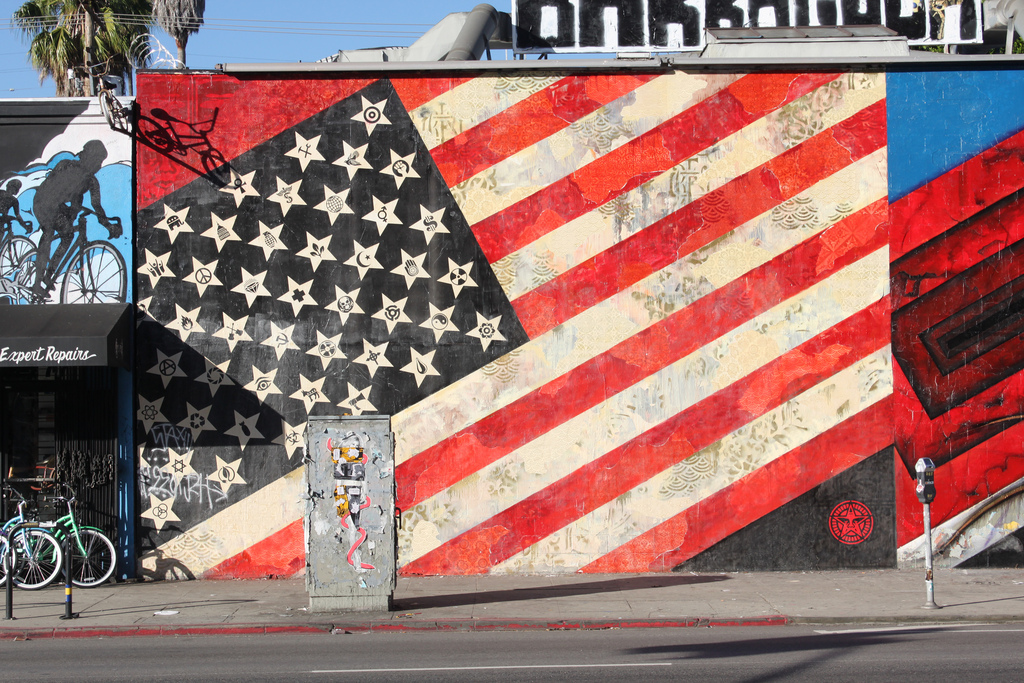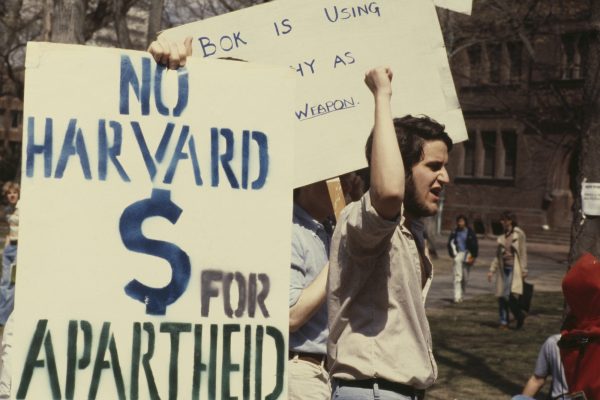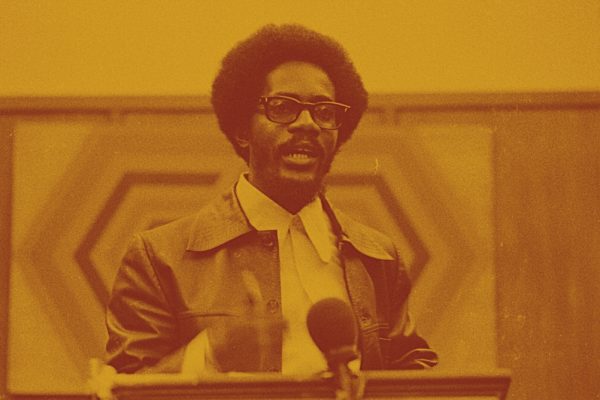Many progressives resist stories valorizing American national identity—but that resistance comes with a political cost. Ever since John Winthrop assured the seventeenth-century Puritans of the Massachusetts Bay Colony that “we shall be as a City upon a Hill,” most Americans have considered themselves a providentially chosen people. The remarkable success of Britain’s thinly populated and poor North American colonies in becoming an independent nation, then a thriving one, then the world’s largest industrial economy, and then the world’s greatest military power has persuaded many that America is indeed exceptional.
Yet this heritage of American exceptionalism is also historically linked to the perceived superiority of white, patriarchal identity. The Europeans who founded the colonies regarded themselves as religiously and culturally superior to the non-Europeans they encountered, which for them justified taking land from indigenous peoples and imposing chattel slavery on blacks. Indeed, in their first Congress in 1790, the new Americans legislated that to be naturalized, a person had to be “white,” a term that initially was just shorthand for being of European descent. By the nineteenth century, the notion that America was a “white man’s nation” was a common political theme. In 1858 Stephen Douglas argued for this heritage explicitly in the Lincoln–Douglas debates, saying “this Government was made on the white basis. I believe it was made by white men for the benefit of white men and their posterity for ever, and I am in favor of confining citizenship to white men.” Despite Lincoln’s strong rebuke of this claim, the version of our national identity endorsed by Douglas has ebbed and flowed over the years.
Since the first Congress of 1790—when new Americans legislated that to be naturalized, a person had to be white—the idea of America as a “white man’s nation” became common.
For any nation to endure, the population must embrace, and its institutions and policies must largely embody and express, narratives of community identity. These stories can be religious myths of “chosen peoplehood,” or historical tales of a nation’s military glory or political greatness, or celebrations of a people’s intellectual and artistic products, or other sources of national distinction in which members can proudly share. But they usually also include veneration for a nation’s founders, and sometimes, as for Douglas, odes to ancestral greatness buttress claims to racial or ethnic superiority.
Such narrow, chauvinistic nationalism has remained stubbornly resilient in America. Indeed, even though Donald Trump and most of his supporters disavow explicit white nationalism, the 2016 election energized “alt-right” leaders such as Richard Spencer, who echoed Stephen Douglas in saying, “America was, until this last generation, a white country, designed for ourselves and our posterity. It is our creation and our inheritance, and it belongs to us.” Whether or not Trump supporters consciously see themselves as proponents of “white nationalism,” there can be no doubt that for many of the most fervent, their vote to “make America great again” was a vote to restore their sense of American identity—what they believed an earlier, whiter, maler, more Christian America was like.
Proponents of humanitarian moralities, such as John Rawls and Jürgen Habermas, have long stressed the value of focusing national identities on political commitments to constitutional democracy and human rights. But it is not hard to see why these civic conceptions have a difficult time competing with the passions and commitments aroused by more ethnic definitions of national identity. Ethnic definitions are especially stubborn when fueled by fears of loss. There is little doubt that the results of neoliberal globalization have fostered economic anxieties and resentments among many native workers, not only those who have lost jobs or endured stagnant wages. These trends have also made many white Americans feel they are losing political power to shape their nation’s destiny. New immigrants, large corporations, and foreign agencies seem increasingly in command.
Americans are not alone in these fears. Proponents of the European Union, for example, have struggled to articulate a story of European peoplehood that inspires allegiance—hence, Brexit. And apart from the embattled Angela Merkel in Germany, most European national leaders have in recent years distanced themselves from multicultural politics, lest they become targets of fierce movements to “take our country back.” Indeed, most modern states that embrace democracy and human rights are struggling to sustain more inclusive conceptions of national identity against resurgent exclusionary and authoritarian nationalisms.
So how do we compete with Trump’s brand of such nationalism here at home? The answer is threefold: it involves first, a more compelling retelling of the Declaration of Independence–based story of American identity that supports egalitarian inclusiveness as America’s core purpose; second, a better understanding of how and why simple calls for “equal” rights effectively undermine a robust multicultural identity; and third, a new civic ethos that supports that narrative by prompting citizens and nations to think not only of how they can avoid harm to others, but how they can realize their goals in ways that do the most to assist others. This strategy could lead to policies that promote both economic welfare and cultural recognition for all, including at least some who are drawn to exclusionary nationalism because they feel their economic and cultural interests are being ignored or assaulted.
• • •
For many Trump’s victory seemed like a death blow to the late twentieth-century dreams of a cohesive multicultural identity. The 1960s had helped inspire the modern women’s movement and a host of other civil rights struggles on behalf of religious, cultural, and linguistic minorities, non-white immigrants, disabled people, LGBTQs, and more. For a brief period, it seemed like the United States was becoming one of a growing number of “multicultural” and “civic” nations.
This multicultural civic identity soon fostered tensions, however, because in preceding civil rights struggles, both reformers and resisters had primarily articulated the concept of equal rights as a struggle for uniformity in citizenship laws. All American citizens, many reformers thought, should have identical bundles of rights and duties, and then American society would be colorblind, gender-blind, and difference-blind. But to many minorities, those bundles of rights soon did not seem blind at all. Full citizenship remained largely defined by the rights, duties, and ways of life that most middle-class, heterosexual, religious white men possessed and pursued. Public policies generally reflected the values and interests of economically, culturally, and politically powerful communities, not the values and interests of all groups. Some, mainly on the left, concluded that if public policies and practices impose uniform treatment and fail to accommodate differences, there can be no meaningful equality of rights and opportunities. Policies would maintain in substance, if not in words, America as a white man’s nation.
Full citizenship remains largely defined by the rights, duties, and ways of life of middle-class, heterosexual, religious white men.
So in the last half-century, we have seen the burgeoning of rights movements that earlier struggles for “difference blindness” would not lead us to expect. They represent efforts to realize civic equality not through uniformity but through appropriately differentiated citizenship, with different bundles of rights and duties assigned—sometimes temporarily, sometimes permanently—to different groups of citizens, based on distinctive features of their identities: racial, ethnic, and linguistic minorities; religious communities; immigrants; the disabled; women; non-heterosexuals; the very young and the very old. Even conservative religious groups share the core argument of many cultural minorities that uniform laws, which refuse to accommodate legitimate differences, often unjustly privilege political, economic, and cultural elites at the expense of all others.
To be sure, this debate has a long history. Early twentieth-century women’s rights advocates wondered whether protective labor laws aided or hindered the progress of women. In the mid-century, Jehovah’s Witnesses claimed that they were being denied equal religious freedom if their children were required, like all others, to salute the American flag at school. Many African American leaders have questioned whether black nationalist initiatives or demands for integration were the best ways to combat the evils of Jim Crow. Today this debate between equality as uniformity and equality as appropriately differentiated treatment is most commonly identified with controversies over racial and gender affirmative action programs.
But it is wrong to identify calls for “different but equal” citizenship rights simply with affirmative action, or even with modern liberal positions more broadly. Americans across the political spectrum favor some forms of differentiated citizenship—even though the forms they favor vary greatly. For example, young children pay taxes if they have earnings, though some rich adults do not. Yet few would argue that small children should be given the voting rights of adult citizens. Most Americans also believe there should be some special accommodations for disabled people in public institutions—such as being allowed extra time on standardized school and job tests—even though this gives them opportunities that other citizens do not have. Similarly, many think it is fine to allow those over the age of sixty-five to ride free on public transit, regardless of their income.
It is especially significant that many conservatives today fiercely insist that traditionalist religious believers who own businesses or nonprofits should be granted special exemptions from medical coverage requirements that help employees obtain contraceptives. Many also say these believers should retain tax-exempt status even while endorsing candidates—relieving them of what are now legal obligations for everyone else. In reality, in twenty-first-century America, the belief that public policies should treat at least some individuals and groups differently from other citizens, in order to make them truly equal citizens, is so widespread as to be nearly universal. Yet many say accommodating differences they do not like violates the “total allegiance to the United States of America” that President Trump demanded in his “America First” inaugural address.
• • •
How can we make this “different but equal” concept part of an American identity story that can compete with Trump’s narrow “America First” view? The first step is to develop a narrative of the nation’s core purposes, drawing on America’s Declaration of Independence, that makes greater egalitarian inclusiveness over time a basic commitment, not a threat. It must be a story that most Americans recognize not only as deeply constitutive of their national identity but as the best story of who they are and what America should be. Antebellum critics of slavery advanced just such a story, arguing, as Lincoln did, that the Declaration of Independence was the “apple of gold” at the center of the Constitution’s “silver frame,” a “maxim” set up to be “constantly looked to, constantly labored for, and even though never perfectly attained, constantly approximated” in ways that could augment “the happiness and value of life to all people of all colors everywhere.” This narrative, embraced by most major American social movements, provides a more morally inspiring sense of the intrinsic worth of American peoplehood than the primarily economic accounts favored by many centrist and left critics of multicultural ideas, who urge progressives to return to a New Deal or Marxist focus on public job creation and public assistance programs alone.
The broad appeal of this story persists. In recent years, it has been carried forward, if in very different ways, in both the second inaugural addresses of George W. Bush—who said that “advancing these ideals,” securing the rights of “every man and woman on this earth,” is “the mission that created our Nation”—and Barack Obama. In his second inaugural address, Obama emphasized that “what makes us American” is “our allegiance to an idea articulated in a declaration made more than two centuries ago”—an idea that has placed Americans on “a never-ending journey” through “Seneca Falls, and Selma, and Stonewall” as they have sought “to bridge the meaning of those words with the realities of our time.” But it never appeared in the rhetoric of either major candidate in the 2016 presidential campaign, and it is fundamentally inconsistent with President Trump’s “American First” vision.
How can we make this “different but equal” concept part of an American identity story that can compete with Trump’s narrow “America First” view?
To defeat that view, retelling this story as it has been told in the past is not enough. Trump and many others often tell disadvantaged Americans to be satisfied with a formal equality of rights that belies a crippling inequality of social conditions. Frequently they seek to impose on all communities self-interested “mainstream” American conceptions of how people should live. Or else they assert that the American project of securing basic rights is for American citizens only, and generates no responsibilities to advance meaningful possession of human rights for others.
But modern labor and civil rights struggles have shown that, beyond establishing formal legal rights, public policies must help people acquire the economic, educational, and political resources and capabilities they need to secure these rights in practice. The best way to do so now is through public infrastructure spending on transportation, communications, education, water and energy supply systems, and environmental enhancements. These investments could generate employment for displaced native workers and immigrants alike, weakening nativism, while spurring sustained economic growth that can advance the pursuits of happiness of all for decades.
But people’s notions of happiness legitimately vary, as do the social, economic, and political barriers they face. To be effective, policies seeking to enable all to enjoy their basic rights securely cannot treat all persons in strictly uniform fashion. The story of America as a nation dedicated to securing rights for all to pursue happiness as they see it instead implies that America must be a multicultural nation that accommodates diversity. Still, it is a story of a multicultural America that sees itself not as fundamentally divided, but rather as building on the best aspects of its common heritage to engage in a shared enterprise that benefits all.
To progress in this pursuit, the United States, like other modern democracies, must engage in continuing, changing contextual judgments about what forms of differential treatment of groups and identities, what forms of aid and accommodation, will augment “the happiness and value of life” for all concerned—and what forms of differential treatment will instead foster divisions, inequalities, and injustices. Those answers will rarely be incontestable, and they will change as social, economic, and political contexts change. Auto workers in Flint, Michigan, for example, did not need opportunities for work in public infrastructure construction projects, alternate energy production, or retraining and relocation programs in the 1950s, when the American auto industry dominated world markets. But today those investments would ensure former auto workers are included in the national quest to secure rights to pursue happiness for all. Conversely, Catholics were an oppressed minority deserving accommodations in public education policies in the 1840s, when Protestants in Philadelphia demanded that their Bibles be used in public schools and rioted against objecting Catholics. American Catholics have less claim to be oppressed today, so their claims for accommodations should be more limited. Both examples show that hard questions of appropriately differentiated policies are ones to which we can find answers, based on good empirical evidence of current social, economic, and political conditions and practices and good studies of what the likely consequences of different policy options are.
• • •
In the quest for those answers, Americans need to develop a civic ethos that encourages all to pursue, among the diverse forms of happiness they may seek individually, those that are most valuable to others as well as to themselves—in part because those choices do most to permit and sometimes assist others in pursuing their distinctive forms of happiness. Modern societies professing liberal democratic principles have often defined the justice they seek in terms of John Stuart Mill’s “harm principle,” which contends that “the only purpose for which power can be rightfully exercised over any member of a civilized community, against his will, is to prevent harm to others.” To avoid ethnocentrism regarding what is “civilized,” many have since adapted Mill’s harm principle in the manner of the American philosopher and antislavery advocate Ralph Waldo Emerson, by suggesting that each person is entitled to the maximum “self-defined” freedom and self-realization possible, consistent with the self-defined freedom and self-realization of others.
This generally commendable turn to protection of “self-defined” freedoms heightens the danger that persons pursuing different forms of self-realization will not cooperate but clash. That is why a new civic ethos is needed. In the diverse America of the twenty-first century, we have come to recognize ourselves as complex, multiply constituted beings who might seek satisfying forms of self-realization in many ways—ways that, while they would provide roughly equal satisfaction for us, might have very different consequences for others. It is right for us to feel obliged to take those consequences into account, individually and collectively.
In the diverse America of the twenty-first century, we have come to recognize ourselves as complex, multiply constituted beings who might seek satisfying forms of self-realization in many ways.
We should augment Mill’s maxim by positing: “the best uses of their powers by communities and individuals are those that aid others, without doing harm to themselves.” Both to meet our own goals and to do what is just and good for our fellow citizens, and fellow human beings we should strive not only to prevent harms. We should seek to exercise our individual and national freedoms in ways that benefit others, along with ourselves. If we can meet our energy and economic needs, but in ways that are less damaging to the global environment and other countries, we should do so. When we pursue common goods through policies that impose burdens on minority cultural and religious practices, we should offer those groups some accommodations and exemptions, whenever doing so involves no real harms to anyone else’s opportunities and enables those groups to pursue happiness, as they define it, more successfully.
This view of justice means legislators and executives devising public policies, and courts adjudicating them, should, rather than regarding any differential treatment as suspect, reverse the burden of proof when responding to the claims of the wide range of advocates for special exemptions and accommodations—including religious groups; linguistic, cultural, ethnic, and racial minorities; the disabled; women; LGBTQ people; children; and the elderly. Lawmakers and courts should only reject the claims of groups to special accommodations when those denials are necessary to achieve compelling governmental purposes—purposes that must be more than simple hostility to the groups in question, and which must not include any allegiance to the idea of America as a white Christian nation. And to be truly just as well as to be truly multicultural and widely acceptable, those efforts at accommodation must include traditional conservative groups, as well as new immigrants and new cultural communities.
This may sound like a formula for fragmentation if not anarchy. Yet if we accept that each group and individual should have rights that have comparable value to, but that are not more valuable than, those granted to other groups and individuals, we may still often find that denials of demands for special rights and accommodations are justified by compelling state interests. Once accommodations are provided to any one group, they must be provided to all groups who similarly claim those accommodations are vital to their pursuits of happiness. Both legislators and courts must ask what the consequences will be of granting, for example, exemptions from Affordable Care Act requirements not only to conservative religious groups and to corporations owned by a religious family, but to all entities who make similar demands. If there are many such bodies, then the accommodations in total may be too costly, both in dollars and in terms of impact on other public goals, to be sustainable. Similarly, if we permit religious groups to endorse political candidates, as President Trump has urged, we must allow all tax-exempt advocacy groups to endorse candidates. We cannot grant religious traditionalists full political speech rights and tax exemptions, while denying them to environmental and human or animal rights advocacy groups. But broadening eligibility for these exemptions might erode political support for them.
Yet whenever demands for accommodations really are confined to a small number of groups, businesses, and individuals, and whenever the interests of those adversely affected by accommodations can be met through relatively costless alternative policies (such as access to contraceptives by other means than employer plans), then it is wise to support those accommodations. So long as accommodations and exemptions do not go so far as to permit violations of basic civil rights, these accommodations may well contribute to civic peace and heighten civic engagement. And the very diversity of modern America makes it reasonable to expect that many requests for special privileges will be confined to so few groups that they can be safely granted.
A renewed attention to reasonable accommodations might mean that the federal government’s initiatives to combat unjust inequalities and meet human needs, like health insurance, public education, and employment discrimination programs, would gain broader support, because groups with different beliefs would feel their concerns had been heard. Such pro-diversity policies might also result in the flourishing of a wide variety of civil associations, long thought to be America’s best schools for citizenship, where the practice of working cooperatively for the pursuit of common goods is paramount. Most importantly, a wide range of cultural communities might come to feel that they are truly part of the larger American political community. And they might then work together to realize a vision of America as a multicultural but united nation which seeks to make meaningful enjoyment of the basic Declaration of Independence rights possible for all.








